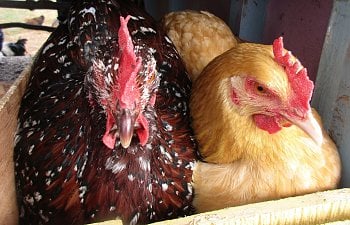Buying Chickens- What to look for?
When buying chickens, whether it's for the first time or not, we all get excited. We know though that it requires research and sometimes that can take a lot of time. In this article, I have combined almost all of the basic information you need to get started. In my last article I discussed getting the right breeds for you, now I'm going to discuss what to look for when buying new chickens. I'll go through these questions: How to tell if the birds you are buying are healthy? How to tell pullets from cockerels? How to tell if you are getting good laying hens? This article will give you a few tips and help to make your job a whole lot easier.
How to tell if the birds you are buying are healthy-
Buying healthy birds is always important. You want to make sure you are getting healthy birds so you don't have to spend money to treat them or so that they won't infect the rest of your flock. Here's some signs to look for, not just in the birds but from the place you are buying them from too.
-Check the holding. (Clean tidy farms are an indication of better hygiene therefore their birds are less likely to have disease)
-Check the other birds on the farm to see if they seem bright, alert and active.
-Check your chosen chicken(s). - Are they bright, active and scratching around? (Note: Dull, withdrawn, hunched chickens are generally unwell)
-Check for diarrhea in the pen.
-Check the bird’s vent is not pasty. (Droppings sticking to the feathers which can block the poop, this can be fatal)
-Listen for sneezing and congestion.
-Check for runny or swelling in the eyes.
-Check the eyes are bright and clear with no discharge.
-Look at the feathers of the chicken. (If they are ruffled and the feathers don't seem neatly together they are likely unhealthy)
-Check for mites and lice.
-Look for scaly leg. (Symptoms are raised encrusted, thickened scales)
-Check the muscle on either side of its breast bone. (Very prominent breast bones are a sign of being underweight)
-Check the pads of the chickens feet for abscesses and ulcers.
Now if the chickens have a couple of these signs it might be okay to bring them home you can nurse them back to health if you wish, but just remember that if you have other birds, quarantine your new ones from them for 3 weeks just to make sure they don't have some illness and they won't infect your existing flock.
Keep in mind also, if you buy from a NPIP flock the birds are tested yearly, and the facility is inspected by a USDA or State Veterinarian, you will most likely not be able to visit the chicks or pens because of biosecurity rules.
How to tell pullets from cockerels-
When buying new chickens you want to be able to tell females from males, especially if you want them for egg laying. Above 5 months of age chickens are generally pretty easy to tell which ones are females and which ones are males, but what about when they are still young?
By one week old, pullets (females) usually have wing and tail feathers developing earlier than cockerels (males).
By five weeks old:
-Cockerels are usually bigger than pullets.
-Cockerels have a bigger, redder comb.
-Cockerels are braver and more friendly.
-Cockerels have longer, thicker legs.
-Cockerels have a curved, stumpy tail.
-The feathering in cockerels is less developed all over - on the legs, back, side of neck, crops, wing bows and flank you may see quills or down rather than well developed feathers.
(Keep in mind some techniques may not work because of the breed and the temperatures that the chicks were raised with, as this will affect their feathering)
One great trick that will work with any chick is to note their behavior when you put your finger in front of their faces/beaks. Pullets will cower down, while cockerels will stand up to you.
How to tell if you are getting good laying hens-
When buying chickens for laying eggs you want to make sure that they are at the right age of egg laying and that they aren't "lemons". As a rule, go for bright eyed, active birds with bright, red combs rather than those that look dull and depressed.
Ones that have a brighter comb are usually good egg layers and in their first year of egg laying. Pullets with little or no comb coloration are probably still young and are not at the egg laying age yet which is 6 months. The picture below is how to tell egg layers and non egg layers apart.
In a hen that is actively laying, the pelvic (hip) bones are widely spaced, and the keel (breastbone) is tilted downward. These two changes provide more room for the development of eggs inside the abdomen. On the other hand, a non-layer’s hips will be narrowly spaced, and less distant from its breastbone.
Thanks so much for reading everyone! I hope this article has helped you in your chicken adventure. Look for the first part of this article, Buying chickens- What breeds are right for you?

